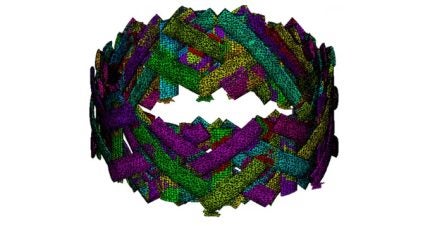
US-based General Atomics Electromagnetic Systems (GA-EMS), under contract with the US Department of Energy (DOE) has developed a “Nuclear Fuel Digital Twin”. This is a modelling and simulation capability intended to help accelerate the process of nuclear fuel qualification and licensing for current and next generation reactor materials. GA-EMS completed preliminary development of four individual performance models in support of its SiGA silicon carbide (SiC) composite cladding technology.
“A digital twin is a virtual representation of a physical object or system – in this case our SiGA cladding nuclear fuel system,” said GA-EMS President Scott Forney. “When complete, this digital twin will allow us to predict SiGA performance within a nuclear reactor core, reducing fuel development and testing costs and reducing the time it will take to get regulatory approval for this revolutionary technology, without sacrificing safety.”
A multi-scale modelling approach was taken where each individual model covers a different length scale – from a mechanism-based microscale model to a reactor system level model. The four individual physics-informed models capture the complex mechanical response of SiGA cladding while exposed to irradiation. In future work, these individual models will be combined into one integrated model called a digital twin.
The SiGA composite is a continuous SiC fibre reinforced, SiC matrix composite material that is the basis of the company’s cladding technology. GA-EMS says SiGA cladding provides both safety and economic benefits to the utilities as it can survive temperatures far beyond that of current materials and can reduce the frequency of fuel reloads.
“We have been able to expedite development and verification of the individual models by leveraging the expertise at Los Alamos National Laboratory and Idaho National Laboratory,” said Dr Christina Back, GA-EMS Vice President of Nuclear Technologies & Materials. “Our work integrally involves dedicated laboratory testing as we develop each performance model. We look forward to continuing to the next phase to bring these individual models together and incorporate them into a greater digital twin framework. Utilisation of the framework to apply the separate effects models appropriately will bring a new level of sophistication and accuracy to efficiently predict fuel performance.”
GA-EMS nearing completion of a 30-month contract with DOE to deliver individual models for nuclear-grade SiGA materials to form the basis of a future digital twin. In February, DOE’s Office of Science awarded a three-year contract to GA-EMS to develop a scalable, cost-competitive path to manufacture silicon carbide (SiC) and SiC composite foam materials for advanced fusion power plants.
GA-EMS is developing high temperature ceramic-based composites for the nuclear environment, including the SiC composite SiGA cladding, which is the material of choice under DOE’s Accident-Tolerant Fuel (ATF) programme. The ATF programme was initiated by an act of Congress in 2012 and is funded and overseen by DOE. GA-EMS is an industry partner on the ATF initiative, providing the ceramic matrix composite fuel rod cladding that replaces the metal cladding (zirconium alloy) used in current fuel rods GA-EMS will leverage its high temperature ceramic fabrication and fusion test facilities to demonstrate the path toward manufacturing first-of-kind SiC and SiC foam materials.
In July, GA-EMS said it had developed silicon carbide nuclear fuel cladding tubes that can withstand extreme temperatures. GA-EMS is developing a new fuel cladding called SiGA with the help of funding, irradiation testing, and post irradiation examination support from DOE’s ATF Programme. Silicon carbide can survive temperatures hotter than molten lava but can be brittle in its pure form, historically limiting its use as a structural material. GA-EMS solved this problem by incorporating silicon carbide fibre into the cladding. The fibre reinforces the material similar to the way steel rebar is used to reinforce concrete. This creates a tough and durable engineered silicon carbide composite material which can withstand temperatures up to 3800°F some 500 degrees hotter than the melting point of zirconium alloy.
GA-EMS has already created 6-inch-long SiGA rodlets and 3-foot cladding samples that meet stringent nuclear power reactor-grade requirements and will undergo irradiation testing at DOE’s Idaho National Laboratory. Recent work has demonstrated the process is scalable to full-length 12-foot fuel rods. GA-EMS believes that SiGA cladding could be demonstrated by the end of this decade, with commercialisation in early 2030. GA-EMS is also developing domestic manufacturing capability for SiGA.
Earlier, in 2020, GA launched a partnership with Framatome to study the use of silicon carbide in boiling water reactor channel boxes as part of Framatome’s PROtect enhanced accident tolerant fuel (EATF) programme. Framatome and GA agreed to test silicon-carbide materials for fuel channel applications, which will reduce the amount of zirconium metal in BWR fuel by around 40%. “Silicon carbide can replace zirconium alloys without having an adverse impact on fuel efficiency,” Framatome said in a statement.






